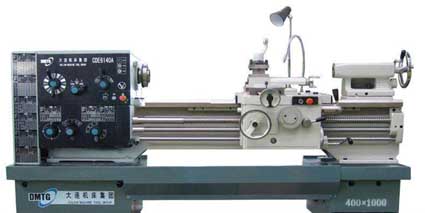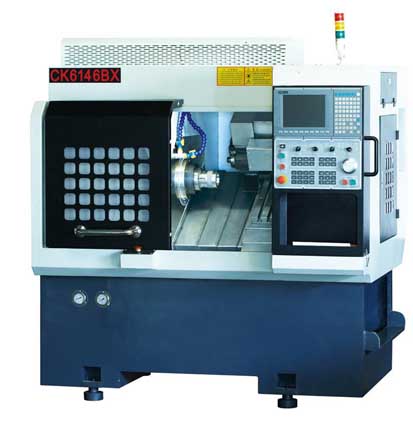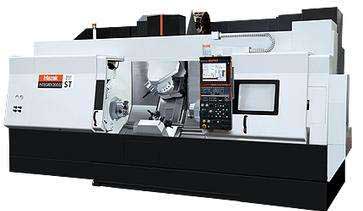Analysis of the Functions of Several Automatic Lathe Equipment

Engine lathe The engine lathe, one of the oldest metal removal machines, has a number of useful and highly desirable attributes. Today these lathes are used primarily in small shops where smaller quantities rather than large production runs are encountered.
The engine lathe has been replaced in today's production shops by a wide variety of automatic lathes such as automatic of single-point toolingfor maximum metal removal, and the use of form tools for finish on a par with the fastest processing equipment on the scene today.
Tolerances for the engine lathe depend primarily on the skill of the operator. The design engineer must be careful in using tolerances of an experimental part that has been produced on the engine lathe by a skilled operator. In redesigning an experimental part for production, economical tolerances should be used.

In designing for low quantities such as 100 or 200 parts, it is most economical to use the turret lathe. In achieving the optimum tolerances possible on the turrets lathe, the designer should strive for a minimum of operations.

Automatic Screw Machines Generally, automatic screw machines fall into several categories; single-spindle automatics, multiple-spindle automatics and automatic chucking machines. Originally designed for rapid, automatic production of screws and similar threaded parts, the automatic screw machine has long since exceeded the confines of this narrow field, and today plays a vital role in the mass production of a variety of precision parts. Quantities play an important part in the economy of the parts machined on the automatic screw machine. Quantities less than on the
automatic screw machine. The cost of the parts machined can be reduced if the minimum economical lot size is calculated and the proper machine is selected for these quantities.

In some cases, tolerances of 0.05mm are held in continuous production using but one cut . groove width can be held to 0.125mm on some parts. Bores and single-point finishes can be held to 0.0125mm. On high-production runs where maximum output is desirable, a minimum tolerance of 0.125mm is economical on both diameter and length of turn.
Automatic lathe
Multi-step machining of small and medium-sized workpieces is automatically completed according to a certain program. It can automatically load and unload, and repeat processing a batch of the same workpiece, suitable for large batch and mass production.
Vertical lathe
The main axis is perpendicular to the horizontal plane, the workpiece is clamped on a horizontal rotary table, and the tool holder moves on the beam or column. Suitable for processing large, heavy, difficult to install the lathe workpiece. There are two major categories, single column and double column.
Shovel tooth lathe
At the same time of turning, the tool holder periodically reciprocates radially for the forming tooth surface of the forklift milling cutter, the hob, and the like. Usually with a shovel attachment, the small grinding wheel driven by a separate motor shovel the tooth surface.
Specialized lathe
A lathe that machines a specific surface of a certain type of workpiece. For example, crankshaft lathe, camshaft lathe, wheel lathe, axle lathe, roll lathe and ingot lathe.
Combined lathe
Mainly used for turning, but with special parts and accessories, it can also be processed by boring, milling, drilling, inserting and grinding. It has the characteristics of "one machine multi-energy" and is suitable for repair work on engineering vehicles, ships or mobile repair stations.
Saddle lathe
The left end of the saddle lathe at the front of the headbox is sunken and can accommodate large diameter parts. The shape of the lathe is two-head high, low in the middle, and looks like a saddle, so it is called a saddle lathe. Saddle lathes are suitable for machining parts with large radial dimensions and small axial dimensions. It is suitable for turning workpiece's outer circle, inner hole, end face, grooving and metric system, inch system, modulus, section thread. It can also be used for drilling, boring and reaming. Especially suitable for single-piece, batch production enterprises. The saddle lathe can process larger diameter workpieces in the saddle groove. The machine tool guides are hardened and finely ground for easy and reliable operation. The lathe has the characteristics of high power, high speed, strong rigidity, high precision and low noise.
Multi Tool semi-automatic lathe
There are single axis, multi axis, horizontal and vertical classification. The layout of the single-axis horizontal type is similar to that of a conventional lathe, but the two sets of tool holders are respectively mounted on the front, back or up and down of the main shaft for machining discs, rings and shaft-like workpieces. Its productivity is 3 to 5 times higher than that of a conventional lathe.
Turret and rotary lathe
It has a turret or a return tool holder that can hold multiple tools. It is possible to use a variety of tools in a single clamping of the workpiece to complete a variety of processes, suitable for batch production.





